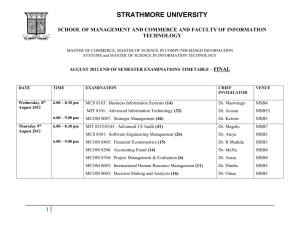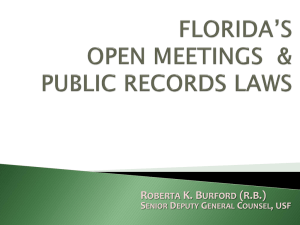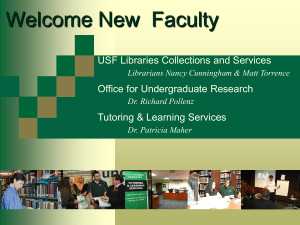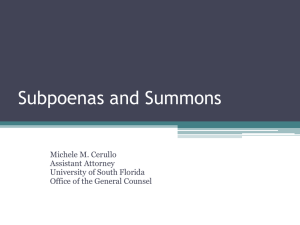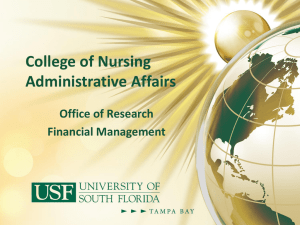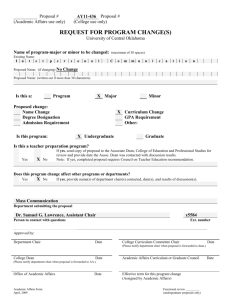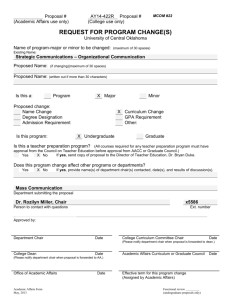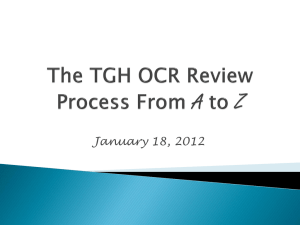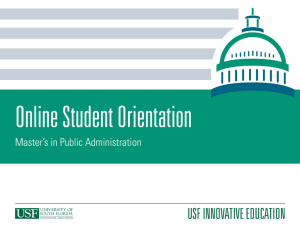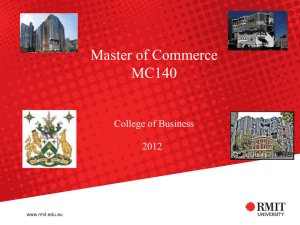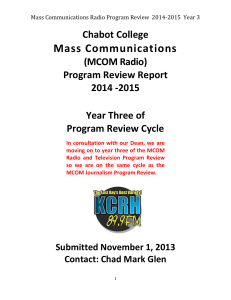USF Health Morsani College of Medicine, Heart Institute
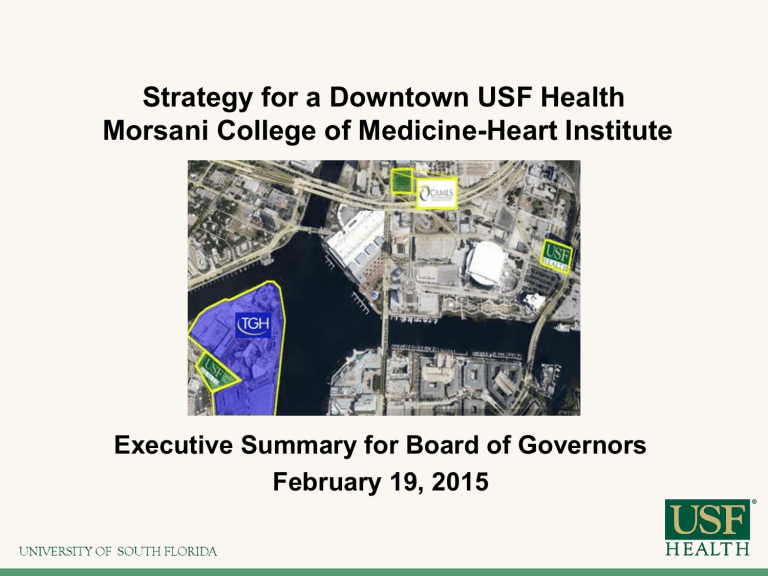
Strategy for a Downtown USF Health
Morsani College of Medicine-Heart Institute
Executive Summary for Board of Governors
February 19, 2015
Advancing the Downtown Strategy
Collaborative and Transparent Process
The initial MCOM request for PECO funds for a new medical school facility occurred 8 years ago, but planning has accelerated over the past 2 years
High level of engagement & feedback obtained from:
– Students, Trustees, Faculty, Legal Counsel
(interviews, surveys, presentations and approvals)
– Outside experts
• HOK (Space Programming)
• Hammes Company (Healthcare Strategy)
• Skanska (Cost Estimating)
– Board of Governors
• Extensive conversations with BOG Staff
• Site visits with 8 BOG members
• Phone conversations with 9 additional BOG members
– Conversations with numerous elected officials
Resulted in unanimous approval by USF BOT, and many letters of support from students, faculty, government and community leadership groups
USF Health Downtown Strategy: Co-locating MCOM and Heart Institute
Current State
“ The Opportunity ”
Future State
“ Solution Based ”
Morsani College of Medicine (MCOM) occupies a 40yr old 192,000 sf facility rated “ Poor ” by NACUBO 1
USF Main Campus is 25+ minutes from MCOM ’ s teaching hospital. No other medical school in the top-
100 medical schools 2 is located as far away
MCOM ranks 63 rd in NIH funding among US medical schools
Challenging recruiting environment due to facility condition and location
Interprofessional strategy is effective and competitive advantage despite distance from teaching hospital
State-of-the-art, 319,000 sf facility to support technology based learning
Downtown location improves proximity to
Tampa General Hospital (5 min vs. 25+ min)
Increased NIH funding moves MCOM into top quartile of US medical schools
New facility and vibrant downtown environment will enhance recruitment of highly competitive students and faculty
Interprofessional advantage improved with expansion opportunities for Pharmacy and proximity to TGH/CAMLS
The result is achievement of an important SUS BOG goal: Improve the quality and relevance of the System ’ s institutions with regard to state, national, and international preeminence
1 National Association of College and University Business Officers
2 Based on 2014 ranking of US medical schools by NIH funding
USF Health Downtown Strategy
Aspirational Goal: Top Quartile Medical School
1
Current State
MCOM ranked 63 rd
($43 Million in NIH Funding)
2014
NIH Funding Rank /
Total Funding ("000s)
Medical School /
Teaching Hospital
Teaching
Hospital
Proximity to
Medical School
42
[$96,318]
43
[$88,080]
63
[$48,019]
118
[$4,872]
119
[$4,860]
126
[$3,090]
130
[$1,300]
UNIVERSITY OF MIAMI
Jackson Memorial Hospital
UNIVERSITY OF FLORIDA
UF Health Shands
UNIVERSITY OF SOUTH FLORIDA
Tampa General Hospital
UNIVERSITY OF CENTRAL FLORIDA
Florida Hospital - Kissimmee
FLORIDA STATE UNIVERSITY
Tallahassee Memorial HC
FLORIDA INTERNATIONAL UNIV
Baptist Health System
FLORIDA ATLANTIC UNIVERSITY
Boca Raton Community Hospital
<10 Min
<10 Min
>25 Min
10-25 Min
<10 Min
10-25 Min
<10 Min
5 years
Impact of Downtown
MCOM moves into top quartile
In NIH Funding
Heart Institute ’s projected $28 million in NIH funding provides momentum by delivering 40% of the funding growth MCOM needs to become top quartile
Student Success:
– Improved student desirability; 88% of accepted, but non-matriculating applicants listed facility quality and teaching hospital proximity as reasons for selecting a school
– New physician scientists expand student research opportunities
Proximity of MCOM/Heart Institute will support mutual success and TGH ’s aspiration to become US News “ Honor Roll ” Hospital
2
1 Top quartile as determined by NIH Funding and US News Ranking
Based on 2014 rankings and funding amounts
Top-100 Medical Schools by NIH Funding
Medical School Proximity to Teaching Hospitals
Of all 138 U.S. medical schools receiving NIH grant funding,
MCOM is the furthest from its teaching hospital
MCOM >25 minutes to Tampa General
More than 88% 1 of medical school applicants view proximity to the teaching hospital as a crucial factor in their selection of a medical school
The majority of interprofessional student interaction occurs in clinical settings primarily located at TGH
Student Success: A Guiding Principle
Since 2013, US public medical school tuition has increased by approximately 20%, while
MCOM has remained flat 1
MCOM tuition and fees will not increase as a result of the downtown development
At the downtown location, students will pay campus rates for parking and will have greater options for parking compared to the limited amount currently on the Main
Campus. Per the agreement with the master developer, MCOM will have access to 100 spaces on site and another 900 nearby
84% of MCOM student survey respondents 2 believe that establishing the MCOM downtown will have a positive impact on student educational experiences
More students currently live within 2 miles of the downtown site than live near the Main
Campus
BOG Performance-Based Funding: Increase number of STEM graduate degrees and postdoctoral appointees
1 As determined by AAMC Tuition and Fees, Total Cost of Attendance Report
2 January, 2015 survey of current MCOM students
Student and Faculty Support
“ We, the elected student leaders at the University of South
Florida Morsani College of Medicine (USF MCOM), wish to formally convey our support for the USF Board of Trustees ’ plan to locate the new facility to house the College in downtown Tampa and respectfully request the approval of the Board of Governors for the Trustees ’ plan.
”
-January 20, 2015 letter to the Board of Governors
“ Whereas, Dean Charles Lockwood has clearly outlined the academic advantages of locating the new facility within walking distance of the Morsani
College of Medicine ’ s primary teaching affiliate,
Tampa General Hospital, as well as the advantages that the proposed new location would provide in recruiting faculty, staff, and prospective students.
”
-University of South Florida Student Government Senate
Resolution JB [R] 55-018
“ The Executive Committee of the University of South
Florida Morsani College of Medicine Faculty Council would like to express our strong support for the proposed expansion of USF MCOM to Downtown
Tampa.
”
-January 12, 2015 letter to the Board of Governors
Innovation and Research Success: USF Health Heart Institute
Unique advantages of a downtown location include:
Proximity to the USF Health Tampa Bay Research and Innovation Center (TBRIC) at
CAMLS, which utilizes multidisciplinary teams of healthcare providers and engineers to assist medical device companies in the entire medical device lifecycle
Enhanced biotech collaboration given USF/TGH ’ s cardiac clinical volume, TBRIC and abundance of planned corporate space
Close proximity to CAMLS featuring world ’ s most sophisticated cardiovascular simulation equipment to enhance training and serve as a platform for CME programs to improve Florida cardiac care
USF Health Heart Institute
The USF Health research enterprise has experienced increasing success in the last three (3) years including strong growth in average NIH funding per new faculty
Shown in the table are the results of
USFH-HI ’ s new grant policy, where the average grant funding per new faculty for the three years prior to the institution of the policy is compared to the three years after the policy.
These results have been used to guide projections for the Heart Institute:
– $28M/year in additional NIH research expenditures anticipated when at full capacity
– Clinical income growth from physician-scientists is projected to increase $1M/yr
The downtown location is expected to accelerate program ramp-up to reach $28 million in NIH funding from 12-15 years on the Main Campus to ~5 years at the downtown site
The downtown site accelerates this curve because investigator access to funds is largely dependent on co-localization with TGH
Without co-location with TGH, recruitment of investigators to the main campus could take longer
USF Health Morsani College of Medicine, Heart Institute Facility
MCOM and USFH-Heart Institute will collectively occupy a 319,000 sf facility located on donated land
The developer, city and county will provide significant contributions in the form of donated land, structured parking, enhanced utilities, site infrastructure and roadway improvements
Program Assumptions
College of Medicine
Heart Institute Labs
Auditorium/Dining/Support
Faculty Offices
Clinical Trials/Care Unit
Subtotal Net Usable
Design Target Average SF
97,585
100,389
41,581
29,610
8,379
277,544 net usable net usable net usable net usable net usable
Grossing Factor
Total Gross Building Area
41,632
319,176
Total Construction
Total Design, Engineering, Civil
Total FF&E
$ 126,254,076
$ 10,439,593
$ 15,958,800
Cost/GSF
$ 395.56
$ 32.71
$ 50.00
Total Project Cost $ 152,652,469
Project Comparison: Main Campus and Downtown
Facility Size (GSF)
Total Project Cost (Construction, Design, FF&E)
Funding Received + Requested Funding
Additional Funding to be provided by
Private Sources
Downtown
319,176
$152.6 M
$130.0 M
$22.6 M
Main Campus
276,492
$149.3 M
$130.0 M
$19.3 M
The square footage difference between the two options is the result of the downtown location requiring space for a library and dining facility; items that are already provided on the Main Campus
While the downtown facility is a larger building, the overall project costs are similar.
This is because the Main Campus has approximately $16 million of infrastructure costs not required by the downtown option.
Project Comparison: Main Campus and Downtown
Included in the downtown facility cost is a minor expense to design and construct the building foundation to support two (2) additional floors
This approach preserves the option of adding the
College of Pharmacy program to the downtown building in the future
USF is receiving substantial benefit at the downtown location via donated site ($10 M) and a substantial proportion of infrastructure costs
(parking structure, district water chiller, storm sewer improvements, utility lines, roadway improvements) estimated to total $40 million.
In the downtown location, all funds can be utilized for program spaces.
USF Health Morsani College of Medicine, Heart Institute: Funding
USF proposes funding the $153 million project cost from the following sources:
Funding Sources
Heart Institute $50 M
COM from FLA
Morsani Gift
$62 M
$18 M
Addtl Private Support $23 M
TOTAL Funding $153 M
$41 million will come from private sources
The downtown plan does not represent an incremental PECO cost to the state .
Over the next 18 months, USF will galvanize private support to provide 27% of the total project cost
Return on Investment
Student Success: At no additional cost to MCOM students, the downtown location will
– Enhance student training and education due to proximity to TGH/CAMLS;
– Increase number of STEM graduate degrees and postdoctoral appointees
– Provides students access to services and programs on par with leading medical schools in the country
By leveraging private support, Florida gains a superior facility for its investment than would have been built otherwise
The downtown strategy will increase NIH grant funding and will position MCOM to move from a current ranking of 63 rd to become a top-quartile medical school
The USF Health Heart Institute is projected to drive up to $73 million annually in local economic activity 1
Co-location of USF Heart Institute with TBRIC and TGH has the potential to attract new Biotech companies to Tampa
Florida is a net exporter of medical graduates, but if we can retain them for both medical school and residency, there is a 65% chance of retention, helping to meet workforce needs
1 Based on economic impact study commissioned by AAMC which indicates that for every dollar of research funding, $2.60 of local economic growth is generated
Before you today: BOG Funding Request
As the next step, following the initial $5 M appropriated by the 2014 Legislature and approved by the Governor, USF requests $17 M as part of a total $62 M multiyear request to develop MCOM in downtown Tampa
Total PECO Funding
Requests for MCOM
Facility
Year
2014
2015
Amount
$ 5M
$17 M
2016
2017
TOTAL
$20 M
$20 M
$62 M
